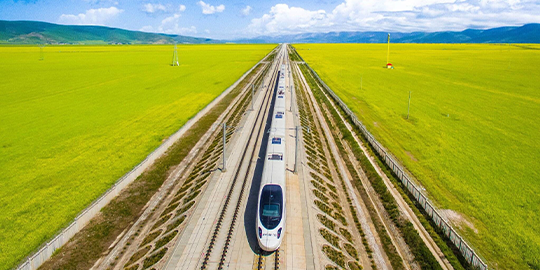
Cutting-edge technology for a safe, competitive and "green" train
No one questions the need for a major change in mobility to progress towards a more sustainable model, one that helps transport passengers and goods using less polluting and more efficient transport, such as rail. However, to do this it is necessary to increase the competitiveness of rail transport and make it more attractive.
Technology is the essential ally to be able to achieve this. Innovative solutions that facilitate mobility as a service, improve safety and optimize infrastructure capacity and maintenance are already beginning to reach the sector, making the train more competitive.
Indra is already working successfully on these solutions which will enable the railroad system to be at the center of this new “greener” transportation ecosystem, within the framework of numerous European RDI projects that will shape the future of the sector. These include the European InSecTT project and the X2RAIL-3, 4 and 5 projects of the European innovation program Shitf2Rail, in which Indra has participated in more than 20 projects as a member of the Governing Board.
Over the past year, Indra has also joined the highest decision-making body of the Europe's Rail (EU-Rail) initiative, the largest European rail innovation program in history, to continue the work carried out in Shift2Rail and to further develop its advanced technology for the sector. The goal is to take advantage of all the benefits of CyberRail IoT, satellite ERTMS, digital twins, big data and Artificial Intelligence to turn the train into the center of the new mobility ecosystem and put it at the service of the traveler.

IoT and wireless communication
For example, the development of a secure IoT rail network based on wireless communication can offer huge opportunities to move towards more automated, safer and smarter railroad management.
“We are working on innovative wireless communication-based solutions which interconnect infrastructure and train devices with control centers and cloud platforms. These solutions make it possible to reduce the safe distance between trains and even their virtual coupling, thus increasing frequency, infrastructure capacity and competitiveness. This is in addition to the greatest advancement, Automatic Train Operation, otherwise known as an autonomous train”, as Indra’s Mobility market experts explain.
The fact that the new communications networks are wireless facilitates not only the coverage in areas where there is no previous network infrastructure or which are difficult to reach, but also the maintenance involved. Smart Maintenance, being both intelligent and predictive, is one of the areas with the greatest potential for technological development as well as economic and environmental benefits.
“The new developments are integrated with the big data capabilities of our In-Mova Space platform. They are based on all available historical data and simulate neural networks, through deep learning algorithms, establishing “hidden” relationships between the variables and probability of errors. This enables us to anticipate required maintenance actions, which currently hinder railway operators,” the experts explain.
Advancements in wireless communications will also make it possible to transform existing infrastructures, with their own technological legacies, in ways that can accommodate the safest and most advanced systems, such as ERTMS, without the need for substantial investment, as is the case at present.
Indra also hopes to transfer its experience in the aerospace industry and the advantages that can be gained by focusing on innovation in the so-called New Space era to improve rail transport signaling and safety.
Digitalization and cybersecurity: the keys to success
In this new hyper-connected ecosystem, cybersecurity is essential. Indra is developing new Edge Computing protocols and Artificial Intelligence algorithms “capable of identifying the origin of an external signal and disconnecting devices automatically when the threat is detected."
The new technologies that Indra is working on are applied to both infrastructure and transport nodes, creating the Smart Station concept, which would enable interaction with all the mobility management information.
Moving forward with this vision of multi-modal mobility supported by the global integration of transport, traffic, infrastructure and logistics data and the digitalization of passenger services, is also key to achieving more sustainable, smart and efficient mobility.
Mobility as a Service
This vision would also enable the definitive step towards MaaS (Mobility as a Service) models.
Indra shares that vision: its In-Mova Space platform connects and integrates the entire mobility ecosystem and orchestrates public transport services, while the comprehensive travel companion application, the Travel Partner app, makes it possible to plan a multimodal trip from door to door, with barrier-free access to any means of transport, and to bill at the end of the month for the mobility services used, instead of charging for each trip.

Add new comment